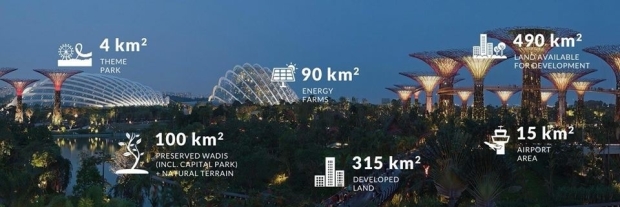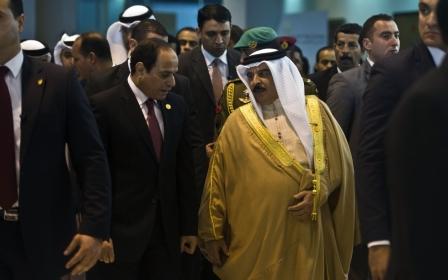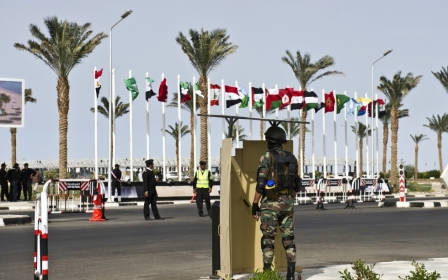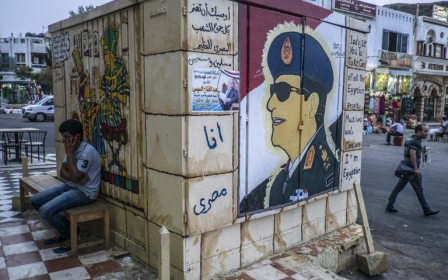Doubts raised over achievability of Egypt's 'new capital'
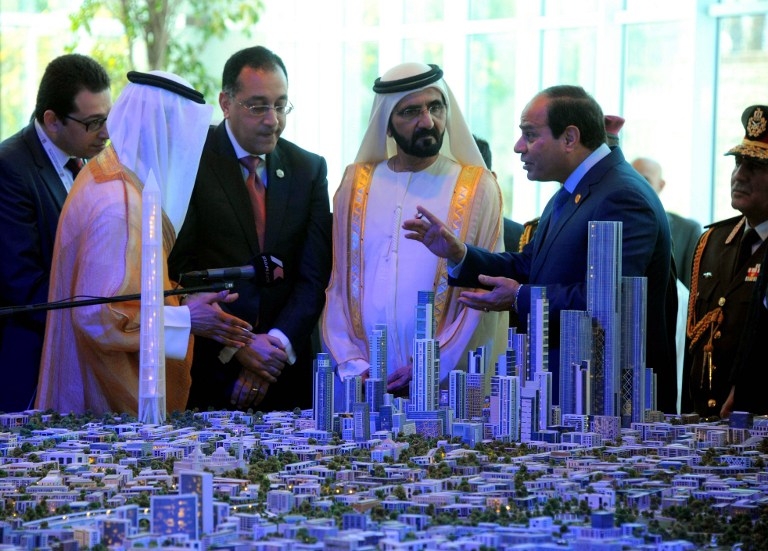
After more than 1,000 years of Cairo being the capital of Egypt, the Egyptian government announced on Friday plans to build a $45 billion replacement called “New Capital” east of the Nile.
Instead of being announced to locals or Egyptian journalists, the plan was rather directly unveiled to foreign investors during the donor and investment conference at the coastal resort Sharm el-Sheikh where Egypt managed to woo more than $12bn in Gulf aid.
“Egypt has more wonders than any other country in the world, and provides more works that defy description,” said housing minister, Mostafa Madbouly, as he unveiled the project in front of 30 visiting emirs, kings and presidents, and hundreds of would-be investors.
“This is why it is necessary for us as Egyptians to enrich this picture – and to add to it something that our grandchildren will be able to say enhances Egypt’s characteristics.”
The city is expected to span 700 sq km, or be about the size of Singapore, with an airport larger than London’s Heathrow, a park double the size of New York’s Central Park, and a theme park four times as big as Disneyland – all to be completed within five to seven years.
According to a brochure handed out in the conference, there will be exactly 21 residential districts, 25 “dedicated districts”, 663 hospitals and clinics, 1,250 mosques and churches, and 1.1m homes housing at least five million residents, reported the Guardian.
Although initially planned to take more than 10 years to build, President Abdel Fatah el-Sisi called out during the conference and in the attendance of his guests, saying, “ten years is too long, make it five.”
The idea of building a new capital was originally announced under ousted President Hosni Mubarak by his son Gamal, but the project was abandoned after an initial feasibility study proved the plan too expensive and unrealistic.
Although purpose built cities were built in the 1960s and 1970s – Islamabad, Brasilia, Chandigarh and Canberra – analysts say the new Cairo capital, is the most ambitious project in human history.
According to Cairo specialist Nezar al-Sayyad, Professor of Architecture, Planning, Urban Design and Urban History at University of California, Berkeley, if compared to other schemes that were meant to create a new administrative capital for a country or a region, “the plan is farcical and fails to achieve any prerequisite of success.”
David Sims, a Cairo-based urban planner told the Guardian: “It’s just a bunch of crazy figures,” he says. “The scale is huge, and there are questions like: how are you going to do the infrastructure? How are you going to get the water? How will they move all these ministries? In other words, I think it’s just desperation. It will be interesting to see if anything comes of it, but I rather doubt it.”
While several experts highlighted the premature nature of the plans that seem to be more of a "propaganda stunt" to attract investors, Sayyad pointed out that images of Egypt's new capital revealed during the economic conference were actually of Marina Bay Sands and Gardens by the Bay in Singapore.
"What should have been truly embarrassing is that some of the images shown in a video at the conference [were] in the presence of a delegation from the country [Singapore] from which they were stolen with no apparent shame."
Egypt has previously experimented with the idea of new towns to satellite developments to curb overcrowding in its main cities. Since the presidency of Anwar Sadat in 1970s’, during which a new towns policy was adopted, new cities were built out in the desert – Sadat City, west of Cairo, 10th of Ramadan, east of Cairo and Al-Amiriyya, near Alexandria – but most of them remain majorly unfinished towns.
In the example of Sadat City - planned in 1975 and inaugurated by Mubarak in 1982 which was meant to include a new administrative city - an entire section called the ministries complex remains signposted showing the location of the different ministries which after 30 years remain empty sells or have been used for other purposes, explained Sayyad.
But while these new cities were being built, satellite developments or gated towns cropped on the outskirts of Cairo, including New Cairo, Rehab, 6th October City. Because they were more proximate to Cairo and therefore more convenient, they relatively filled up at the expense of the new cities, becoming elite enclaves where the rich could live and commute to Cairo for work at the same time.
With around 96% of Egyptians living on just 4% of Egyptian land, the new towns were meant to resolve Egypt’s congestion problems. Yet 22 existing “new towns” – some of them more than 30 years old – still collectively hold little more than a million residents, and contain thousands of empty homes, reported the Guardian.
The reason earlier desert settlements failed to attract residents is largely due to a lack of infrastructure, employment and contradictory urban policies. Satellite developments could not provide enough jobs for poorer residents, or affordable transport to areas where they could find more work, while the new cities were too far out to attract any demographic at all.
“There is a demand to live there [desert cities], but it’s a demand from a very specific group of people, and it’s not a very big demographic,” Nick Simcik Arese, an anthropologist at the Oxford Programme for the Future of Cities, told the Guardian.
“People do want to abandon Cairo and live in their secessionary envelope. But to do that you need a car, and that means you have to have a certain income to live there.”
Sayyad expects a similar fate for the new administrative capital: “The most likely outcome will be something will be built and a lot of money will go into it. It will be a failure but not a monumental one, because as a real-estate development – the most profitable investment in Egypt - some people will move in.”
Building a new city instead of solving Cairo’s problems has left many Cairenes wondering why the government doesn't invest in the capital that they already have, while also raising concerns that planned projects for Cairo taking a back seat.
“With pumping of all this money into the city, development projects for transport, waste management and jobs in Cairo will be ignored. It is a focus on the wrong thing,” said Harry Pettit, an urban geographer at the London School of Economics whose focus research area is Cairo.
Sayyad agrees: “It is laughable to leave a city that is already 20 m and build another city that is meant to be twice its size for only 5 m with money that you don’t have on land that doesn’t even have water and in an area that is very distant from any kind of existing urbanisation.”
“An investment in solving the tremendous infrastructure problems in Cairo itself to make it a liveable city with a quarter of the money pledged with be infinitely more appropriate.”
The Sisi government announced at the conference that it has hired a Dubai-based "private real-estate investment fund" called Capital City Partners, whose founder, Mohammed Alabbar, built Dubai's iconic Burj Khalifa skyscraper, to build the new capital.
According to Gulf Business magazine, a major part of the new city is expected to be named after one of the UAE's leaders.
Despite government declarations, Dubai's Alabbar, also chairman of Emaar Properties announced Monday that his company is not involved in a project to build a new administrative capital city in Egypt, reported Reuters.
Emaar, 29 percent owned by state fund Investment Corporation of Dubai, last month filed a request to list its Egyptian unit on Cairo's bourse, and the UAE is a close ally of Egypt's President Sisi.
"We would like to clarify that Emaar is not involved in the development of the new capital city project in Egypt," it said, without saying whether it might become involved in future.
Another of Alabbar's companies, Eagle Hills, agreed in January to co-finance and lead Serbia's $4 billion Belgrade Waterfront project, which promises office and luxury apartment blocks, eight hotels, a shopping mall and a tower resembling Dubai’s landmark Burj Khalifa, on the right bank of the Sava River.
Standing behind the deal is the likely to become Serbian Prime Minister Aleksandar Vucic, who campaigned as the candidate who can bring home investment from the UAE, reported Bloomberg on Friday.
The former nationalist, known in the 1990s for his anti-Muslim rhetoric, is stressing his ties with the Arab Gulf nation’s business and political leaders as a source of investment ahead of the 16 March ballot.
New MEE newsletter: Jerusalem Dispatch
Sign up to get the latest insights and analysis on Israel-Palestine, alongside Turkey Unpacked and other MEE newsletters
Middle East Eye delivers independent and unrivalled coverage and analysis of the Middle East, North Africa and beyond. To learn more about republishing this content and the associated fees, please fill out this form. More about MEE can be found here.


